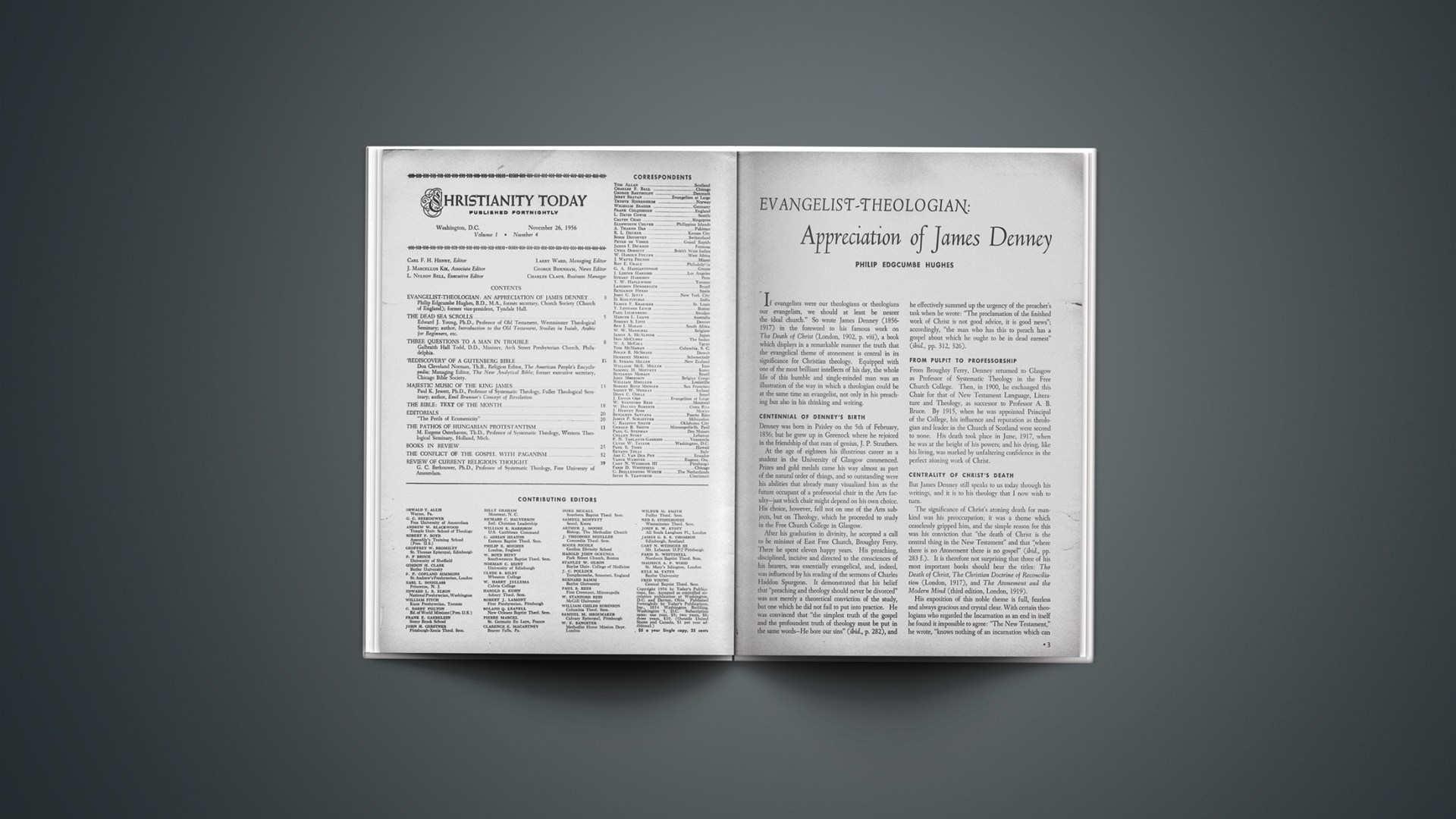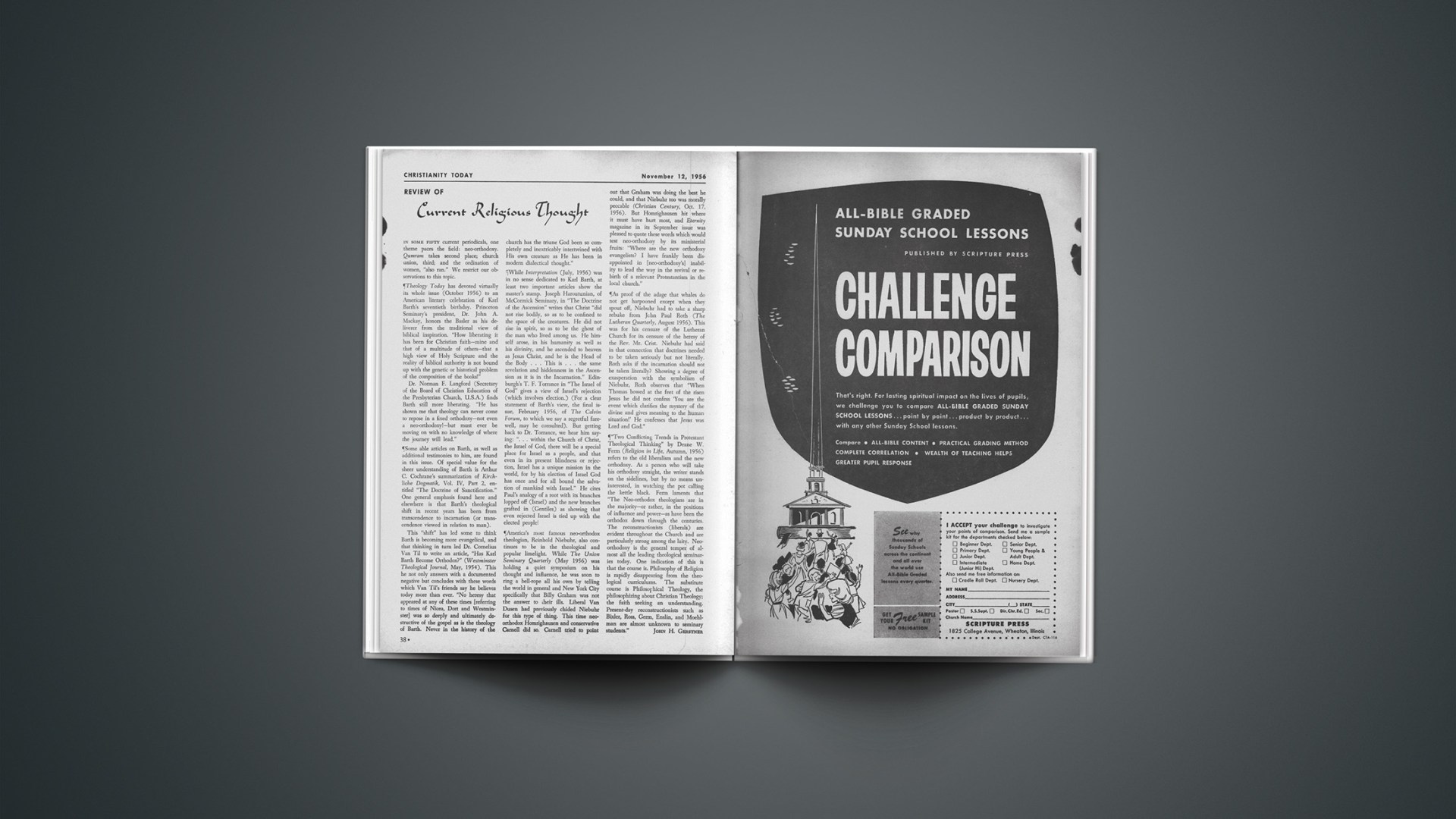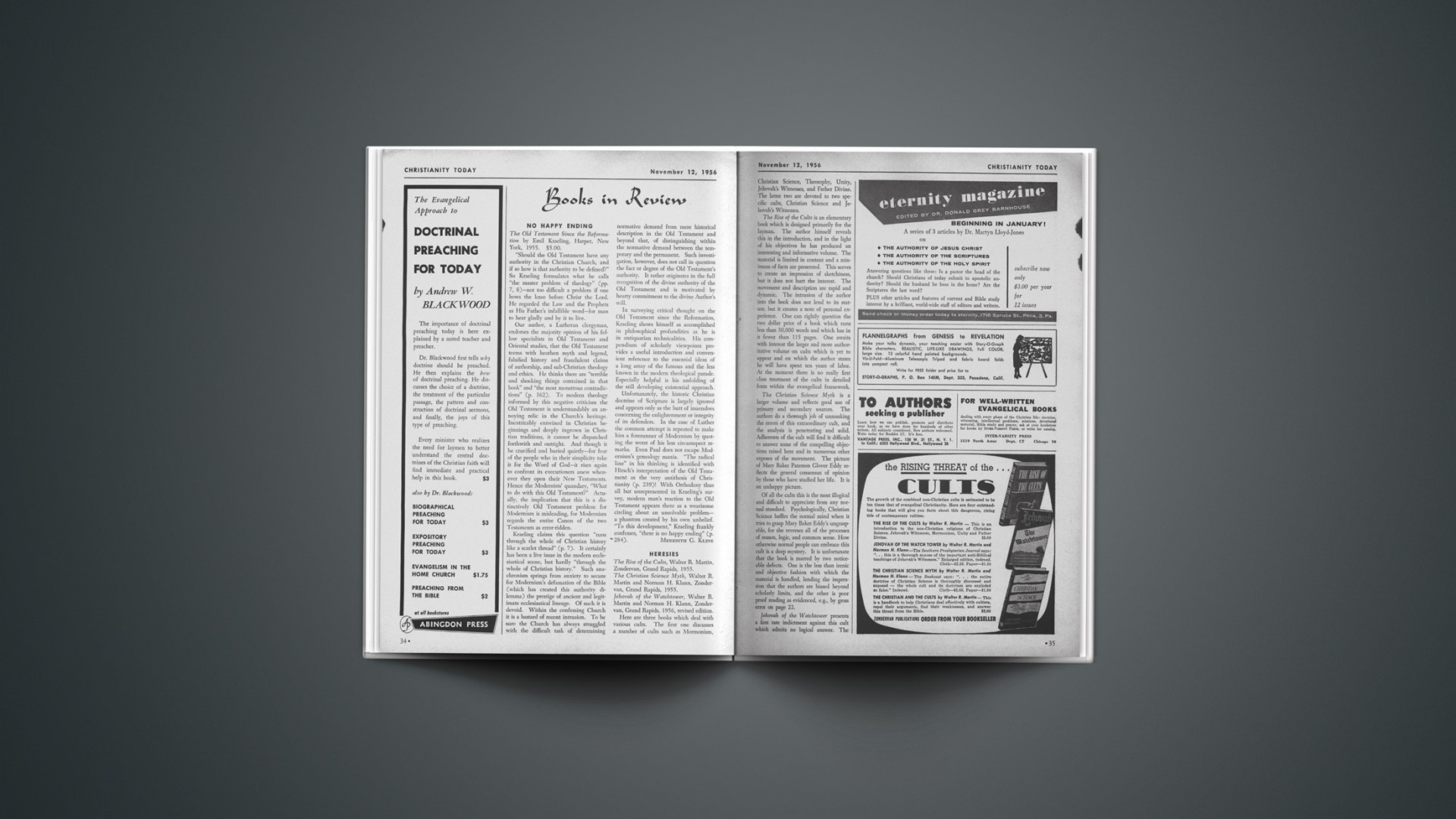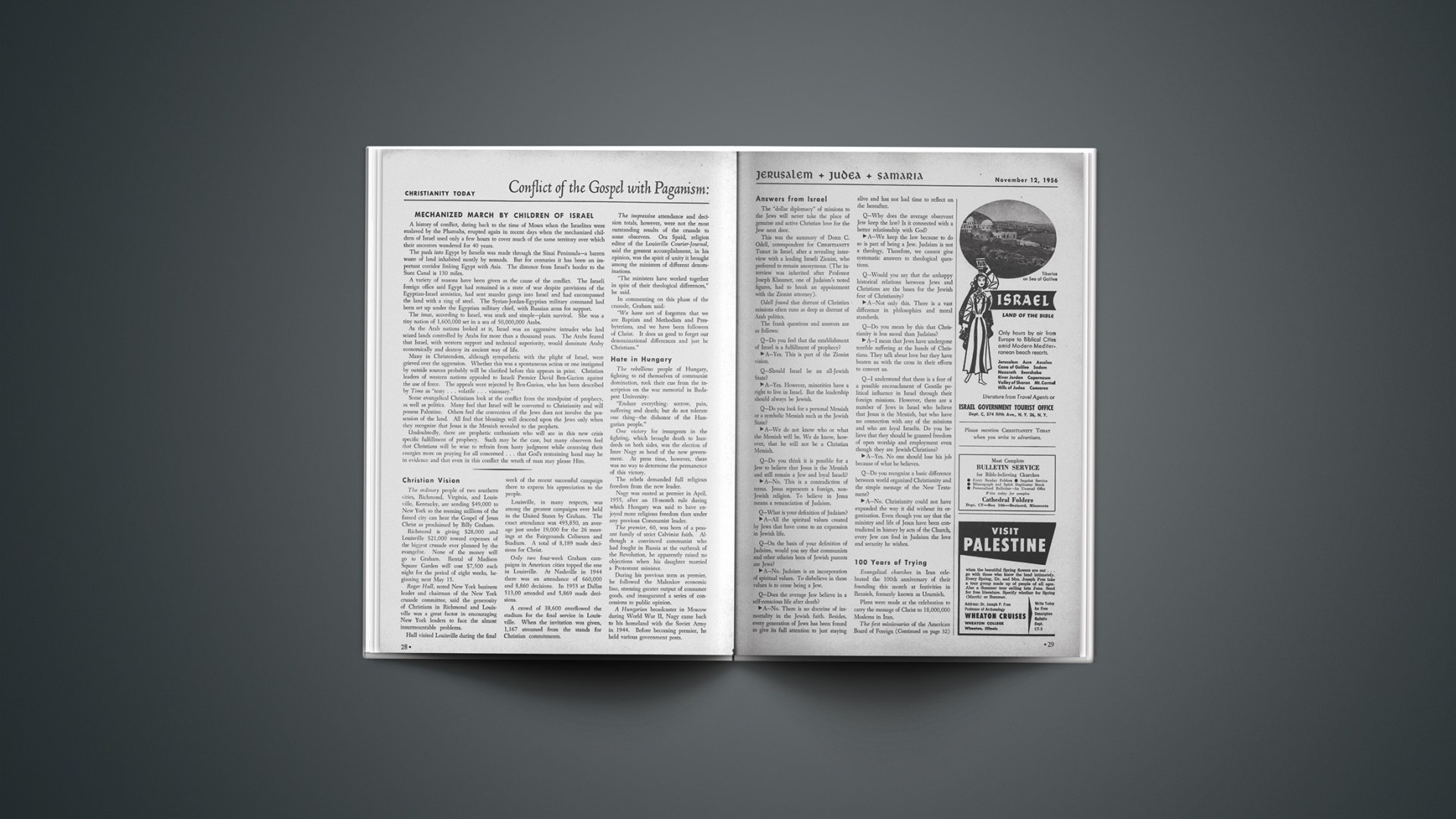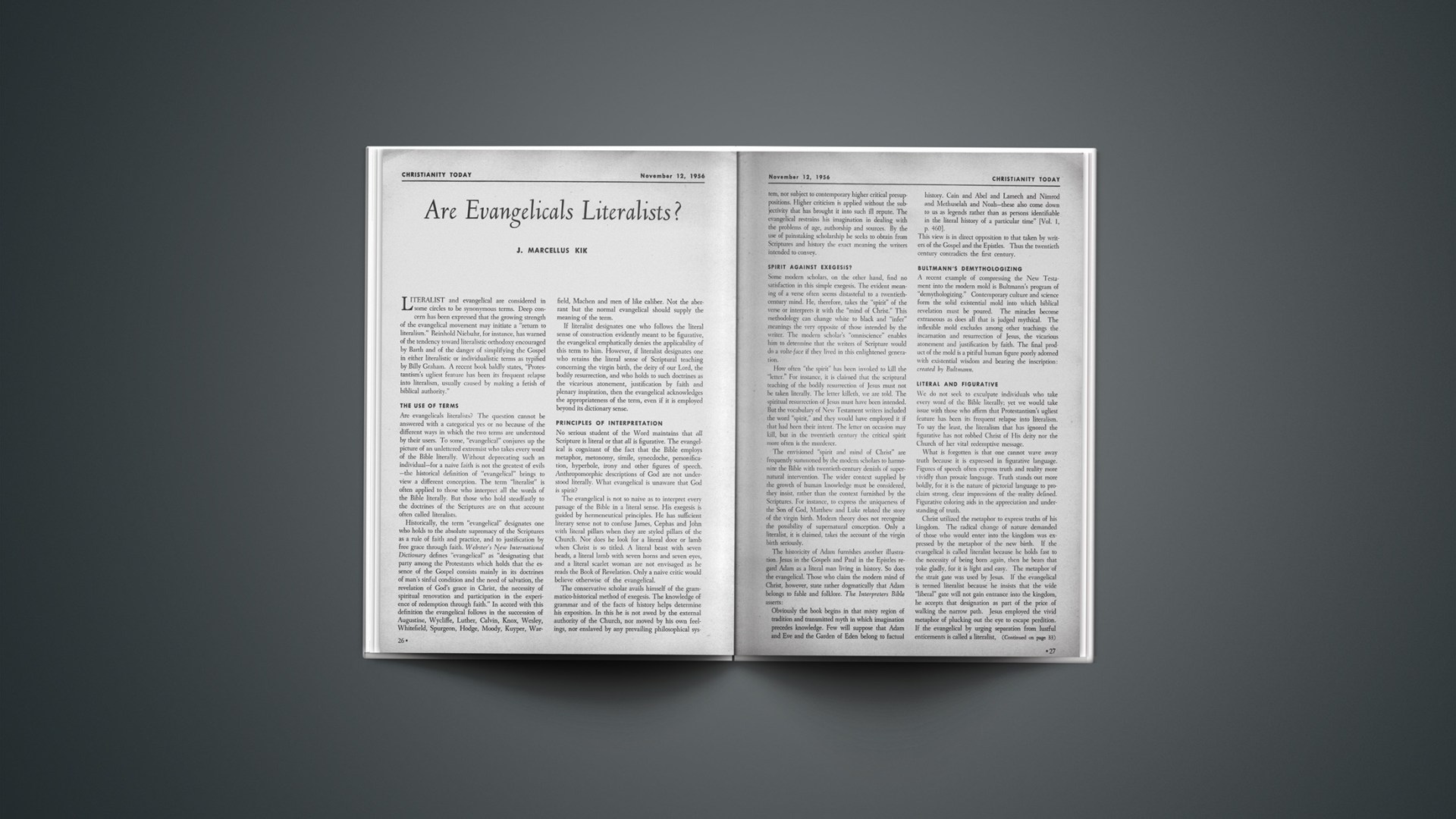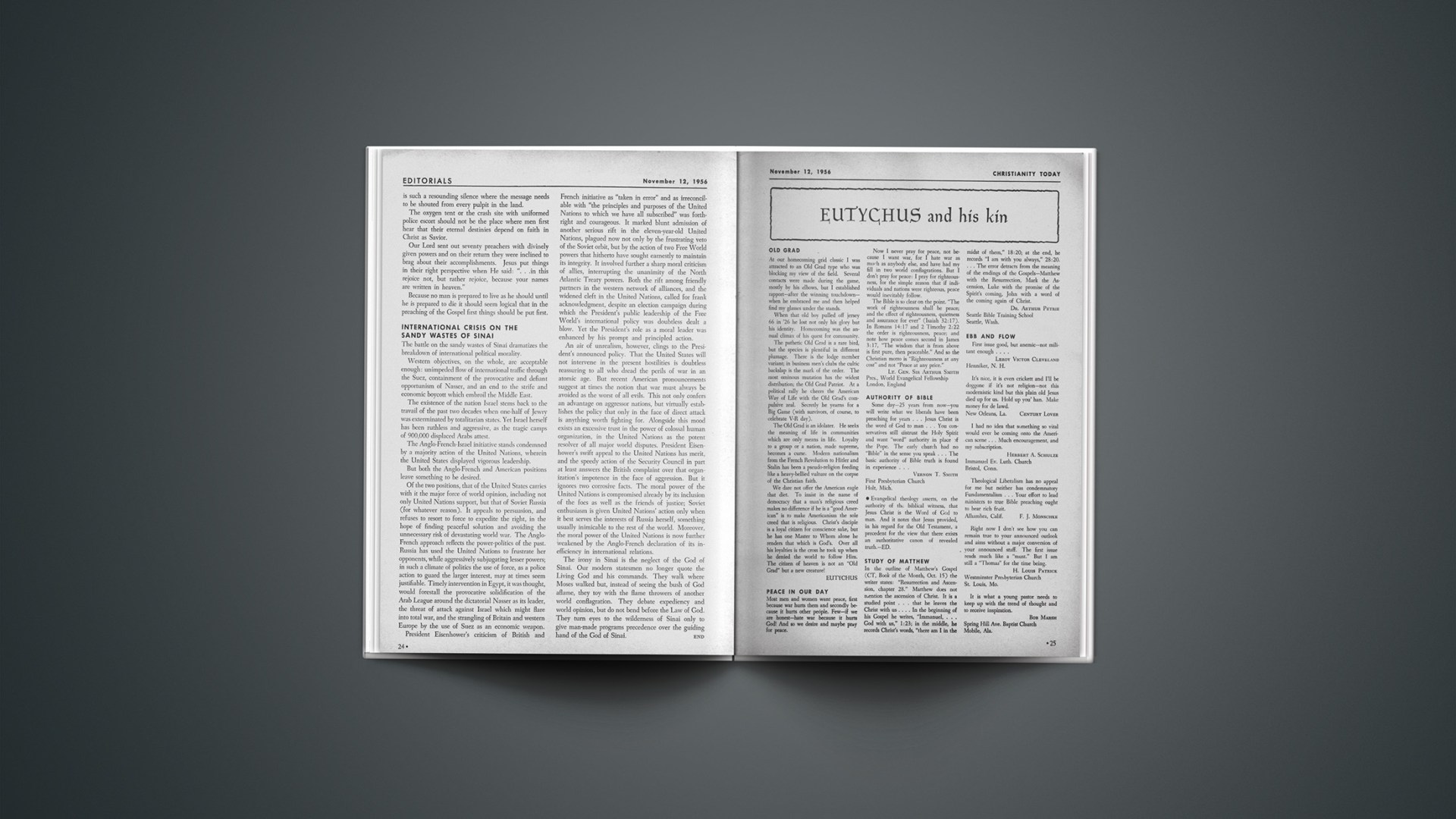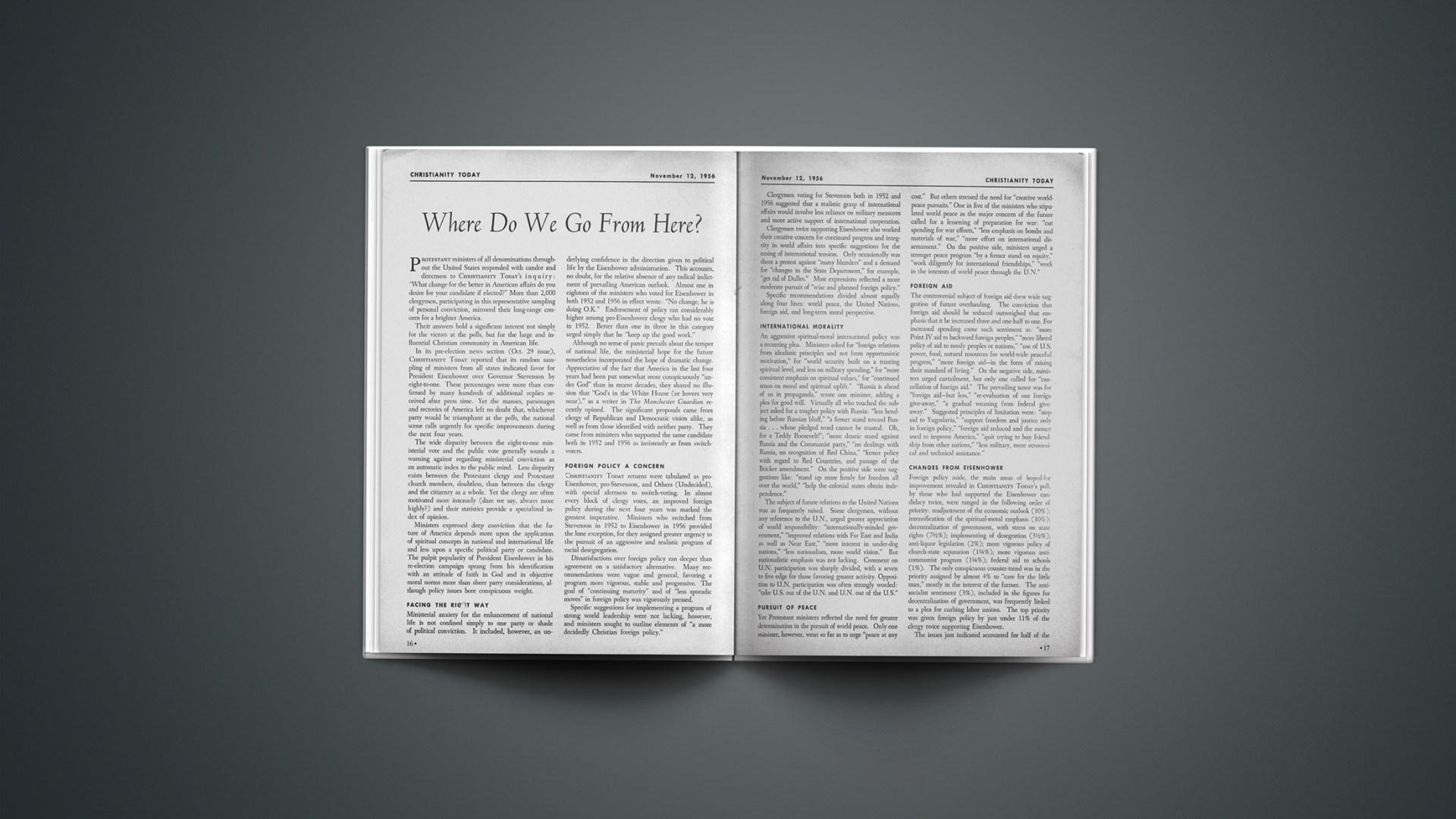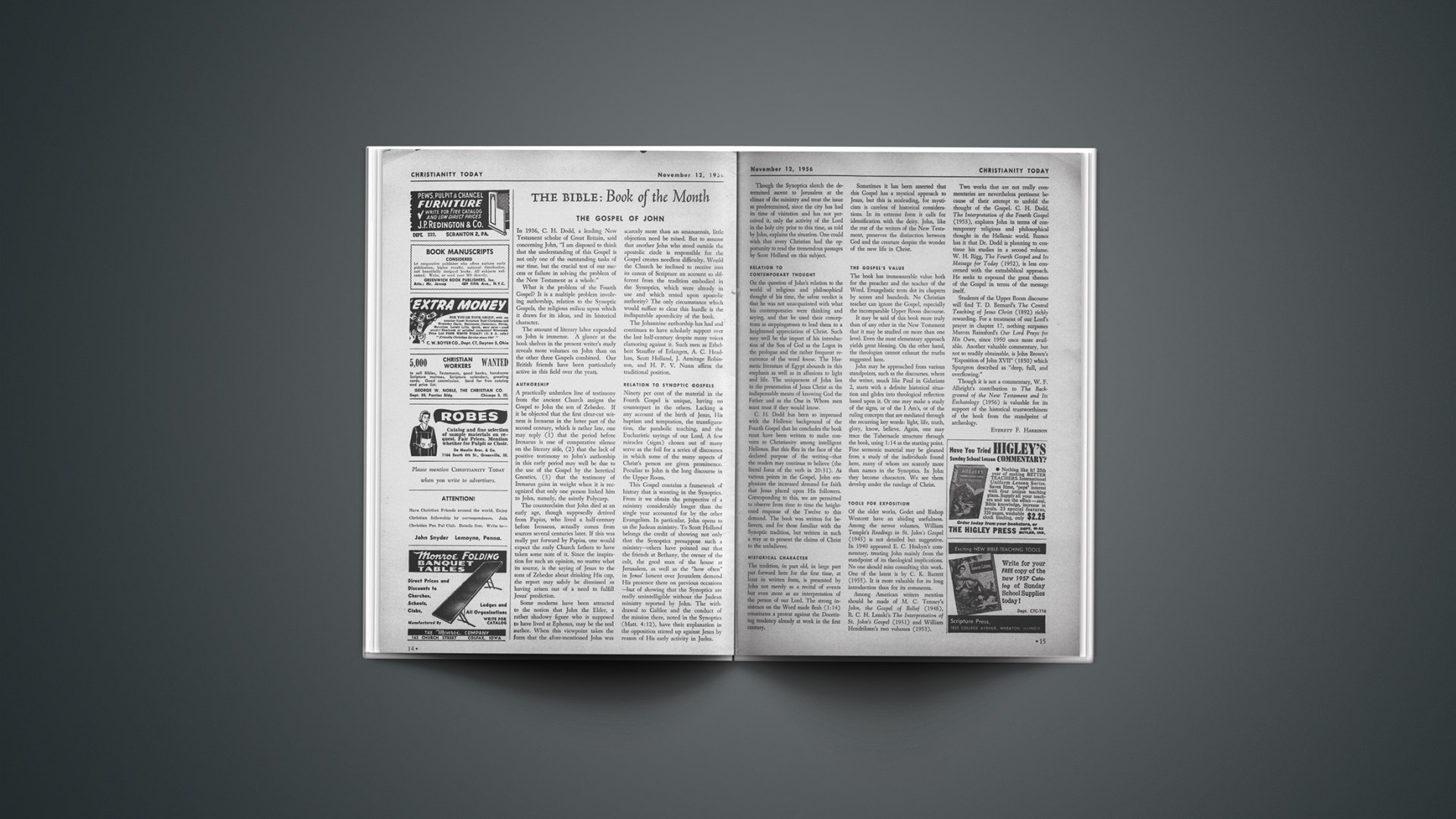“If evangelists were our theologians or theologians our evangelists, we should at least be nearer the ideal church.” So wrote James Denney (1856–1917) in the foreword to his famous work on The Death of Christ (London, 1902, p. viii), a book which displays in a remarkable manner the truth that the evangelical theme of atonement is central in its significance for Christian theology. Equipped with one of the most brilliant intellects of his day, the whole life of this humble and single-minded man was an illustration of the way in which a theologian could be at the same time an evangelist, not only in his preaching but also in his thinking and writing.
Centennial Of Denney’s Birth
Denney was born in Paisley on the 5th of February, 1856; but he grew up in Greenock where he rejoiced in the friendship of that man of genius, J. P. Struthers.
At the age of eighteen his illustrious career as a student in the University of Glasgow commenced. Prizes and gold medals came his way almost as part of the natural order of things, and so outstanding were his abilities that already many visualized him as the future occupant of a professorial chair in the Arts faculty—just which chair might depend on his own choice. His choice, however, fell not on one of the Arts subjects, but on Theology, which he proceeded to study in the Free Church College in Glasgow.
After his graduation in divinity, he accepted a call to be minister of East Free Church, Broughty Ferry. There he spent eleven happy years. His preaching, disciplined, incisive and directed to the consciences of his hearers, was essentially evangelical, and, indeed, was influenced by his reading of the sermons of Charles Haddon Spurgeon. It demonstrated that his belief that “preaching and theology should never be divorced” was not merely a theoretical conviction of the study, but one which he did not fail to put into practice. He was convinced that “the simplest truth of the gospel and the profoundest truth of theology must be put in the same words—He bore our sins” (ibid., p. 282), and he effectively summed up the urgency of the preacher’s task when he wrote: “The proclamation of the finished work of Christ is not good advice, it is good news”; accordingly, “the man who has this to preach has a gospel about which he ought to be in dead earnest” (ibid., pp. 312, 326).
From Pulpit To Professorship
From Broughty Ferry, Denney returned to Glasgow as Professor of Systematic Theology in the Free Church College. Then, in 1900, he exchanged this Chair for that of New Testament Language, Literature and Theology, as successor to Professor A. B. Bruce. By 1915, when he was appointed Principal of the College, his influence and reputation as theologian and leader in the Church of Scotland were second to none. His death took place in June, 1917, when he was at the height of his powers; and his dying, like his living, was marked by unfaltering confidence in the perfect atoning work of Christ.
Centrality Of Christ’s Death
But James Denney still speaks to us today through his writings, and it is to his theology that I now wish to turn.
The significance of Christ’s atoning death for mankind was his preoccupation; it was a theme which ceaselessly gripped him, and the simple reason for this was his conviction that “the death of Christ is the central thing in the New Testament” and that “where there is no Atonement there is no gospel” (ibid., pp. 283 f.). It is therefore not surprising that three of his most important books should bear the titles: The Death of Christ, The Christian Doctrine of Reconciliation (London, 1917), and The Atonement and the Modern Mind (third edition, London, 1919).
His exposition of this noble theme is full, fearless and always gracious and crystal clear. With certain theologians who regarded the Incarnation as an end in itself he found it impossible to agree: “The New Testament,” he wrote, “knows nothing of an incarnation which can be defined apart from its relation to atonement … Not Bethlehem, but Calvary, is the focus of revelation, and any construction of Christianity which ignores or denies this distorts Christianity by putting it out of focus” (The Death of Christ, p. 325).
Objective Aspect Of Atonement
Denney recognized the Atonement as in the first place an objective act of God, and, as such, an act which is consistent with God’s whole character. He thus speaks of the “divine necessity—not to forgive, but to forgive in a way which shows that God is irreconcilable to evil, and can never treat it as other or less than it is” (The Atonement and the Modern Mind, p. 82). So Christ went to the Cross, for “God could not do justice to Himself, in relation to man and sin, in any way less awful than this” (ibid., p. 91).
In this vital respect, as Denney perceived, the modern mind is not different from the ancient; for both “the attraction and the repulsion of Christianity are concentrated at the same point; the cross of Christ is man’s only glory, or it is his final stumbling block” (ibid., p. 3).
The Atonement is, in fact, a revelation both of the love of God and of his justice. “Justice,” declared Denney, “is in no sense at war with mercy. The opposite of justice is not mercy, but injustice, and God is never either unmerciful or unjust.… In the divine nature justice and mercy do not need to be composed, they have never fallen out” (The Christian Doctrine of Reconciliation, pp. 104, 233). The meeting of mercy with justice is seen in the fact of the divine necessity “that sin, in the very process in which it is forgiven, should also, in all its reality, be borne.” No element of the tremendous reality of sin is ignored or evaded by Christ. “On the contrary,” says Denney, “sin is exhausted in His appearance on the cross; the cup is not tasted, but drained.” The ultimate truth about forgiveness was, for Denney, simply this, “that sin is only forgiven as it is borne. He bore our sins in His own body on the tree: that is the propitiation. It is the satisfaction of divine necessities, and it has value not only for us, but for God” (ibid., pp. 161 f.).
Calvary Makes A Difference To God
It was maintained by Denney that “if we say that the death of Christ was an atoning sacrifice, then the atonement must be an objective atonement. It is to God it is offered, and it is to God it makes a difference.” In the ancient Church the death of Christ was universally regarded as “an atoning sacrifice through which sin was annulled and God and man reconciled” (ibid., p. 30); and equally primitive is the conception of Christ’s death as a ransom, the cost of man’s emancipation. These ideas of sacrifice and ransom both “imply that Christ did with God for men something which they could not do for themselves, and which made them infinitely His debtors” (ibid., p. 33). Denney insisted that “we cannot dispense with a work of reconciliation which is as objective as Christ Himself, and has its independent objective value to God.… The world with Christ and His passion in it is a different place from the world without Christ and His passion in it. It is a different place to God, and God’s attitude to it is different” (ibid., p. 236)—and the explanation of this is that it is God’s complete and final act on behalf of sinners: “the one thing needful for the salvation of sinners was once for all done and endured at the cross” (ibid., p. 284).
Subjective Side Emphasized Also
Yet it must not be thought that Denney failed to appreciate that the subjective aspect of the Atonement is also of importance. One who emphasized, as he did, experience as a theological criterion was not likely to make this mistake. “The work of reconciliation,” he affirmed, “must have justice done to its subjective as well as its objective reference; the doctrine must recognise its ultimate effect in man as well as its value for God” (ibid., p. 109).
It is true that he spoke of Anselm’s Cur Deus Homo as “the truest and greatest book on the Atonement that has ever been written” (The Atonement and the Modern Mind, p. 84), but this did not prevent Denney from criticizing the book’s serious inadequacies, nor from appreciating what is of value in Abelard’s view of the Atonement as a demonstration of divine love. Denney urged, however, that “the death of Christ can only be regarded as a demonstration of love to sinners, if it can be defined or interpreted as having some necessary relation to their sins” (The Christian Doctrine of Reconciliation, p. 79).
Significance Of Christ’s Life
Nor should it be imagined that Denney underestimated the significance of Christ’s life as integrally connected with his redeeming function. His study of the New Testament led him to see that Christ’s life “attains its true interpretation only as we find in it everywhere the power and purpose of His death.” So assured was Denney of this truth that he felt able to define Christ’s life as “part of His death: a deliberate and conscious descent, ever deeper and deeper, into the dark valley where at the last hour the last reality of sin was to be met and borne” (The Atonement and the Modern Mind, pp. 108 ff.). But, thanks be to God, Christ’s death is not the end of the story, for it is followed by His resurrection from the dead. “The New Testament,” says Denney, “preaches a Christ who was dead and is alive, not a Christ who was alive and is dead.… To preach the Atonement means not only to preach One who bore our sins in death, but One who by rising again from the dead demonstrated the final defeat of sin, and One who comes in the power of His risen life … to make all who commit themselves to Him in faith partakers in His victory” (ibid., p. 112).
The Atonement And Our Century
This brings us to the question of the reality of the Atonement for man in this twentieth century. What, to use the modern terminology, is its existential significance, if any? This was a question of which Denney was keenly aware.
But he was first of all convinced of the historical foundations of Christianity. “The whole power of Christianity is in its historical character,” he asserted, “and to replace its sublime and tragic facts by a system of ideas, however true and imposing, is to destroy it altogether” (The Christian Doctrine of Reconciliation, p. 131).
But it is precisely in relation to this soteriological history that the existential import of Christianity must be perceived. “There is certainly no reconciliation but through the historical Christ: there is no other Christ of whom we know anything whatever. But,” he adds, “the historical Christ does not belong to the past. The living Spirit of God makes Him present and eternal; it is not from Palestine, or from the first century of the Christian era, but here and now that His reconciling power is felt” (ibid., p. 9). In this sense the Christian believer today is no more remote from Christ and His power than was, for example, the Apostle Paul nineteen hundred years ago. Paul was not philosophizing in the abstract or indulging in academic theological speculation when he wrote his epistles. On the contrary, he was writing of what he had himself experienced. He knew the power of the risen Christ as a reality in his own life; and the same has been true of every believer in every age. With this in mind, Denney was even willing to state that “the basis of all theological doctrine is experience” (ibid., p. 199; cf. Jesus and the Gospel, third edition, London, 1909, p. 36). Thus, while maintaining the full historical character of the Christian religion, he stressed that its saving truth is not limited to the past, but is “here, in the living Christ and in the experience of Christians” (ibid., p. 376).
God Demands A Response Of Faith
The response which God demands from man to the finished work of Christ is that of faith. “He must trust himself to such love instantly, unreservedly, for ever,” says Denney. “He cannot negotiate with God about it.… The only right thing to do is to trust it, to let go, to abandon ourselves to it, keeping nothing back” (The Christian Doctrine of Reconciliation, p. 163). Faith, he explains, is man’s “absolute committal of himself for ever to the sin-bearing love of God for salvation.” Faith, indeed, is “just as truly the whole of Christianity subjectively as Christ is the whole of it objectively” (ibid., p. 291). And when he describes the life of faith as “passionate identification” of the sinner with Christ in trust and love, and as “self-abandonment” to God’s redeeming love in Christ, his words have a genuinely existential ring about them (ibid., p. 324).
Impatience With Creeds
Linked with his emphasis on the criterion of experience was Denney’s dislike of creedal formulations. He felt that there was an ever-present danger lest through their imposition, faith in a person should be displaced, all unconsciously, in favor of faith in articles, and lest any “preliminary demand for orthodoxy” should act as a barrier “between the soul and the reconciling love of God in Christ” (The Christian Doctrine of Reconciliation, p. 109). It was his opinion that the process of intellectualization of the faith was responsible for the transformation, or deformation, of the primitive Church into “the historic Catholic Church.” The metamorphosis of the Church he summed up in three stages: “first a holy society, then a society of true doctrine, and finally a clerical polity” (Studies in Theology, eighth edition, London, 1904, pp. 193 ff.), or hierarchical institution. This, no doubt, is an over-simplification of history, but that does not mean that there is no truth in it. Here, however, we feel bound to urge, against Denney, that the New Testament shows that the preservation of “true doctrine” was very much an apostolic concern—a concern, that is, of the original Church.
What Denney was contending for was the view of Christianity, “not as a theological system, but as a religious life” (Jesus and the Gospel, p. 381), and he was insistent that no Christian was “bound to any Christology, or to any doctrine of the work of Christ” (ibid., p. 382), but to Christ alone. Not, of course, that Denney disparaged the need for Christians to achieve an appreciation of the intellectual implications of their faith, otherwise he would never have devoted his energies to the task of theology; but he demanded for every believer “entire intellectual freedom” (ibid., p. 384), to think things out for himself. The requirement of subscription to “elaborate creeds” he regarded as divisive in the Church, and he advocated the introduction of a brief and simple affirmation of faith which, by contrast, would stand as a “symbol of the Church’s unity.” The formula he proposed was: “I believe in God through Jesus Christ His only Son, our Lord and Saviour” (ibid., p. 398).
Weakness In Doctrinal Position
Once again, it may be objected, Denney has produced an over-simplification. An affirmation of this sort, simple though it is, presupposes not only a doctrine of the person and work of Christ, but also, if it is to be meaningful, a right doctrine. It cannot be divorced from Christology and soteriology—a fact to which, somewhat ironically, Denney’s own careful and extensive writings bear testimony. To contemplate with complacency, as he did, the unity, under cover of this formula, of Arians and Athanasians (ibid., pp. 402 f.), is to fail to perceive that Arianism strikes at the very foundation of redemption in Christ. We do not dispute that many holding Arian views may at the same time have exercised a vital saving faith in Christ, but that does not justify Arianism any more than the presence of hypocrites among the orthodox disqualifies orthodoxy. Nicene Christology cannot be dismissed (as Denney wished to dismiss it) as “explaining nothing,” nor should an otherwise laudable zeal for unity in the Church be permitted to blind us to the necessity for right doctrine.
It is also necessary to suggest that Denney did less than justice to the scriptural evidence when he opposed the classic doctrine of the Trinity, rejecting in particular the personality of the Holy Spirit, whom he defined impersonally as “an experience which comes to people through faith,” the “experience of power, life, and joy” (The Christian Doctrine of Reconciliation, pp. 308 f.).
When his work is viewed as a whole, however, such blemishes as have been pointed out are seen to be incidental; but they are blemishes, nonetheless, and candor demands that they should be pointed out, for they indicate a weak point at the basis of his thinking. That weak point, in our estimation, may be described as an undue bias, in an otherwise finely balanced mind, towards a type of pragmatic subjectivism. But having said that, we remember that James Denney, like the rest of us, was not immune to human frailty and inconsistency.
Unity Of New Testament
The radical and frequently destructive criticism of the New Testament which was at its height in Denney’s day, particularly in Germany, caused him to give himself to a searching and systematic study of the New Testament writings, so that he might assess the validity of this criticism. His verdict was that the New Testament is essentially a unity. In his judgment, the contrasts found within it are not oppositions and there is no justification for speaking, as many were then doing, of “antagonism between the gospel of Jesus and that of Paul, or Peter, or John” (ibid., p. 129). Nor did he approve of the view that the thought-forms of St. Paul are antiquated, incomprehensible, and therefore unacceptable to modern man. To speak like this he denounced as “flying in the face of history and experience.” Denney’s answer here, his appeal to history and experience, seems to me to be irrefutable. The Church today, and not least the theologians, should give careful heed to these words which rose from the wisdom and warmth of his evangelical heart: “There have always been people who found Paul intelligible and accepted the gospel as he preached it,” he said. “There are such people still, if not in theological class rooms, then in mission halls, at street corners, in lonely rooms. It is not historical scholarship that is wanted for the understanding of him, and neither is it the insight of genius: it is despair. Paul did not preach for scholars, nor even for philosophers; he preached for sinners.”
These words show us the essential Denney, the man whose great passion was the Gospel of Jesus Christ as God’s remedy for sinful mankind. They show us, in short, one who was truly an evangelist-theologian.
Philip Edgcumbe Hughes, B.D., M.A., is former secretary, Church Society (Church of England); former vice-president, Tyndale Hall.

